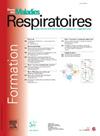使用sirna负载的可切换脂质纳米颗粒靶向COPD中粘液过量产生以沉默SPDEF
IF 0.5
4区 医学
Q4 RESPIRATORY SYSTEM
引用次数: 0
摘要
粘液分泌过多是慢性阻塞性肺疾病(COPD)的关键组成部分,参与气流限制并与全因死亡率增加相关。含sam点结构域的ETS转录因子(SPDEF)是杯状细胞分化所需的细胞内转录因子。使用siRNA下调SPDEF的表达是一种治疗选择,以减少粘液高浓度和恢复粘纤毛清除。然而,一些生物学障碍,如潜在的免疫刺激作用、粘液渗透和支气管上皮递送,仍然阻碍了RNA治疗肺部疾病的疗效。在这里,我们使用可切换的脂质纳米颗粒(LNPs)递送SPDEF siRNA,目的是评估在包括气液界面在内的相关人体模型中靶向SPDEF的潜力。方法分别收集COPD和非COPD患者胸外科手术后肺标本的支气管上皮细胞。在气液界面培养细胞,获得具有黏液层的完全分化上皮。脂质纳米颗粒是通过在乙醇中与PBS缓冲液中靶向SPEDF的siRNA快速混合制备的。上皮细胞暴露于siRNA- lnps 4小时后,通过流式细胞术和共聚焦成像评估siRNA摄取情况。暴露后48和72 h,采用RT-qPCR和western blot检测沉默效率。结果siRNA-LNP能有效地渗透到ALI培养的分化细胞中。共聚焦成像证实siRNA已穿过黏液层并渗透到上皮细胞的细胞质内。siRNA-LNPs在RNA水平暴露48小时后实现SPDEF沉默,在蛋白水平暴露72小时后实现SPDEF沉默。与来自COPD患者的细胞相比,来自对照组的细胞沉默水平没有变化。结论lnps能够克服黏液层并内化到分化的上皮细胞中。该策略可用于递送SPDEF siRNA,有效下调SPDEF的表达。这些结果突出了这种可切换的脂质纳米颗粒制剂用于COPD治疗的siRNA药物的潜力。本文章由计算机程序翻译,如有差异,请以英文原文为准。
Targeting mucus hyperproduction in COPD using siRNA-loaded switchable lipid nanoparticles to silence SPDEF
Introduction
Mucus hyperproduction is a key component of chronic obstructive pulmonary disease (COPD), participating to airflow limitation and associated with an increased all-cause mortality. SAM-pointed domain-containing ETS transcription factor (SPDEF) is an intracellular transcription factor required for goblet cell differentiation. Downregulating SPDEF expression using siRNA is a therapeutic option to reduce mucus hyperconcentration and restore mucociliary clearance. However, several biological barriers such as potential immunostimulatory effects, mucus penetration and bronchial epithelial delivery still hamper the efficacy of RNA therapies for lung diseases. Here, using switchable lipid nanoparticles (LNPs) to deliver SPDEF siRNA, we aim at evaluating the potential of targeting SPDEF in relevant human models including an air-liquid interface.
Methods
Primary bronchial epithelial cells derived from pulmonary samples were collected after thoracic surgery of COPD and non-COPD patients. Cells were cultivated at the air-liquid interface to obtain a fully differentiated epithelium with a mucus layer. Lipid nanoparticles were prepared by rapid mixing of lipids in ethanol with siRNA targeted against SPEDF in PBS buffer. After the exposure of epithelial cells to siRNA-LNPs during 4 h, siRNA uptake was evaluated by flow cytometry and confocal imaging. Silencing efficiency was assessed by RT-qPCR and western blot 48 and 72 h after exposure.
Results
The siRNA-LNP were able to efficiently penetrate into differentiated cells in ALI culture. Confocal imaging confirmed that siRNA have crossed the mucus layer and penetrated within the cytoplasm of epithelial cells. SPDEF silencing was achieved 48 hours after siRNA-LNPs exposure at the RNA level, and at 72 h at the protein level. The level of silencing was unchanged in cells derived from control subjects compared with those obtained from patients with COPD.
Conclusion
LNPs are able to overcome the mucus layer and are internalized into differentiated epithelial cells of a translational patient-derived model. This strategy can be used to deliver SPDEF siRNA, that efficiently downregulate SPDEF expression. These results highlight the potential of this switchable lipid nanoparticle formulation to carry out siRNA drugs for COPD treatment.
求助全文
通过发布文献求助,成功后即可免费获取论文全文。
去求助
来源期刊

Revue des maladies respiratoires
医学-呼吸系统
CiteScore
1.10
自引率
16.70%
发文量
168
审稿时长
4-8 weeks
期刊介绍:
La Revue des Maladies Respiratoires est l''organe officiel d''expression scientifique de la Société de Pneumologie de Langue Française (SPLF). Il s''agit d''un média professionnel francophone, à vocation internationale et accessible ici.
La Revue des Maladies Respiratoires est un outil de formation professionnelle post-universitaire pour l''ensemble de la communauté pneumologique francophone. Elle publie sur son site différentes variétés d''articles scientifiques concernant la Pneumologie :
- Editoriaux,
- Articles originaux,
- Revues générales,
- Articles de synthèses,
- Recommandations d''experts et textes de consensus,
- Séries thématiques,
- Cas cliniques,
- Articles « images et diagnostics »,
- Fiches techniques,
- Lettres à la rédaction.
 求助内容:
求助内容: 应助结果提醒方式:
应助结果提醒方式:


